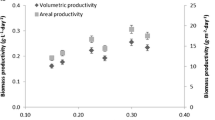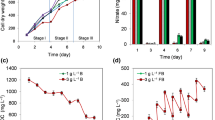Abstract
Arthrospira (Spirulina) platensis M2 was grown outdoors in 50-mm diameter tubular reactors under the climatic conditions of central Italy (Florence) from September to December 1995 and in March 1996. Except for September, the cultures temperature was regulated. Mean productivities of 0.83, 0.44 and 0.61 g dry wt L−1 d−1 were achieved in autumn (September–October), winter (November–December) and March, respectively. In autumn and winter, the photosynthetic efficiency of the cultures and the degree of correlation between productivity and solar irradiance were significantly greater than in summer. The effect of cell density and aeration rate on productivity was evaluated in September. The productivity of cultures operated at high supra-optimal population density was about 30% less at high aeration rate (1.0 LL−1 min−1), and 50% less at standard aeration rate (0.17 LL−1 min−1), than that of control cultures kept at optimal population density and standard aeration rate. The reduction of productivity in high-density cultures was due to lower daylight output rates and higher night biomass losses (the latter were particularly relevant under standard aeration conditions). The main factor limiting productivity in closed reactors during autumn was the night temperature. Heating the cultures during daylight hours on sunny days did not cause any significant increase of the yields, since under sunlight the unheated cultures also reached the optimal temperature for growth early in the morning. On cloudy days, the day-time temperature of the unheated cultures remained well below the optimum, however this had only a limited effect on productivity since algal growth was mainly light-limited.
Similar content being viewed by others
References
Belay A, Ota Y, Miyakawa K, Shimamatsu H (1994) Production of high qualitySpirulina at Earthrise Farms. In Phang SM, Lee YK, Borowitzka MA, Whitton BA (eds), Algal Biotechnology in the Asia-Pacific Region. Institute of Advanced Studies, University of Malaya, Kuala Lumpur, 92–102.
Doumenge F, Durand-Chastel H, Toulemont A (1993) Spiruline, algue de vie. Bulletin de l'Institut Océanographique, Numéro spécial 12, Monaco, 222 pp.
Hu Q, Guterman H, Richmond A (1996) A flat inclined modular photobioreactor for outdoor mass cultivation of photoautotrophs. Biotechnol. Bioeng 51: 51–60.
Kretschmer P, Pulz O, Gudin C, Semenenko V (1995) Proceedings of the 2nd European Workshop on Biotechnology of Microalgae. IGV Institut für Getreideverarbeitung GmbH, Bergholz-Rehbrucke, 154 pp.
Richmond A (1986) Microalgae of Economic Potential. In Richmond A (ed.), CRC Handbook of Microalgal Mass Culture. CRC Press, Inc., Boca-Raton, Florida, 199–243.
Richmond A (1996) Photobioreactor design: Biological principles, or — How to utilise high photon flux densities efficiently. In Abstracts of the 7th Int. Conf. of the International Association of Applied Algology ‘Opportunities from Micro- and Macroalgae’. Knysna, South Africa, 60–61.
Torzillo G, Sacchi A, Materassi R, Richmond A (1991) Effect of temperature on yield and night biomass loss inSpirulina plateensis grown outdoors in tubular photobioreactors. J. appl. Phycol. 3: 103–109.
Tredici MR, Chini Zittelli G (in press) Cultivation ofSpirulina (Arthrospira) platensis in flat plate reactors. In Vonshak A (ed.)Spirulina platensis — Physiology, Cell-biology and Biotechnology. Taylor & Francis, London.
Tredici MR, Chini Zittelli G, Biagiolini S (1992) Influence of turbulence and areal density on the productivity ofSpirulina platensis grown outdoors in a vertical alveolar panel. In Kretschmer P, Pulz O, Gudin C (eds), Proceedings of the 1st European Workshop on Microalgal Biotechnology. IGV Institut fur Getreideverarbeitung GmbH, Bergholz-Rehbrucke, 58–60.
Tredici MR, Carlozzi P, Chini Zittelli G, Materassi R (1991) A vertical alveolar panel (VAP) for outdoor mass cultivation of microalgae and cyanobacteria. Bioresource Technology 38: 153–159.
Tredici MR, Materassi R (1992) From open ponds to vertical alveolar panels: the Italian experience in the development of reactors for the mass cultivation of phototrophic microorganisms. J. appl. Phycol. 4: 221–231.
Vonshak A, Abeliovich A, Boussiba S, Arad S, Richmond A (1982). Production ofSpirulina biomass: effects of environmental factors and population density. Biomass 2: 175–185.
Zarrouk C (1966) Contribution à l'étude d'une cyanophycée. Influence de divers facteurs physiques et chimiques sur la croissance et la photosynthèse deSpirulina maxima (Setch. et Gardner) Geitler Ph. D. thèse, Université de Paris, France.
Author information
Authors and Affiliations
Rights and permissions
About this article
Cite this article
Zittelli, G.C., Tomasello, V., Pinzani, E. et al. Outdoor cultivation ofArthrospira platensis during autumn and winter in temperate climates. J Appl Phycol 8, 293–301 (1996). https://doi.org/10.1007/BF02178572
Received:
Revised:
Accepted:
Issue Date:
DOI: https://doi.org/10.1007/BF02178572




